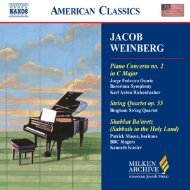Download Liner Notes PDF - Milken Archive of Jewish Music
Download Liner Notes PDF - Milken Archive of Jewish Music
Download Liner Notes PDF - Milken Archive of Jewish Music
You also want an ePaper? Increase the reach of your titles
YUMPU automatically turns print PDFs into web optimized ePapers that Google loves.
further development <strong>of</strong> elements <strong>of</strong> the A section,<br />
which function as countermelodies and counter-ideas<br />
at various points. But it could also be perceived as a<br />
continuous development <strong>of</strong> the High Holy Days kaddish<br />
tune interspersed with episodes derived from the<br />
Festival kiddush melody as well as other, extraneous<br />
melodic bits. Each such episode is introduced by some<br />
component <strong>of</strong> the High Holy Day kaddish tune.<br />
Ever the theatrical composer despite his occasional<br />
protestations, Secunda frequently frames both<br />
themes from liturgical tradition in tasteful<br />
reverberations <strong>of</strong> Second Avenue, including some <strong>of</strong><br />
its typical harmonic language and clichés, original<br />
melodic fragments with popular hints, and chromatic<br />
cascades employed as “fills.”<br />
The second movement suggests a lyrical cantorial<br />
improvisation, built on two similar motives that could<br />
be perceived generically as reflecting either modal<br />
cadential patterns <strong>of</strong> biblical cantillation, or traditionally<br />
ubiquitous events in the complex network <strong>of</strong> Ashkenazi<br />
prayer modes and formulas known in the cantorial<br />
world as nusah hat’filla. In the context <strong>of</strong> a flowing,<br />
unfolding recitative, these motives are presented<br />
by the cello, then in octaves, and then developed in<br />
different registers <strong>of</strong> all four strings. But cello and<br />
first violin are featured. Emblematic ornamentation<br />
is broadened and extended to become an organic<br />
part <strong>of</strong> the melodic structure. There are no specifically<br />
identifiable tunes here, but there are recurring hints <strong>of</strong><br />
typical modalities <strong>of</strong> eastern European brands <strong>of</strong> the<br />
prayer formulas—for example, the flatted supertonic<br />
resolving on the tonic. Accompanimental figures from<br />
the early part <strong>of</strong> the movement become the principal<br />
concluding material.<br />
The third movement is constructed in the classical<br />
minuet form, AA-BB-A (reprise)-Trio-A-B, even though<br />
the first theme has more the character <strong>of</strong> a waltz than<br />
a minuet. The melodic material <strong>of</strong> the A section has<br />
a typical Central European waltzlike flavor, though<br />
it does not appear to be traceable to any specific<br />
source. It proceeds to a radically different exposition,<br />
reminiscent <strong>of</strong> the melos <strong>of</strong> eastern European <strong>Jewish</strong><br />
wedding bands <strong>of</strong> the 19th and early 20th centuries<br />
(erroneously called klezmer since the 1970s, despite<br />
that fact that the klezmorim—i.e., instrumental band<br />
musicians—played widely differing styles and types <strong>of</strong><br />
music at different periods, from at least the Baroque<br />
on, and in disparate regions). Suggestive <strong>of</strong> uninhibited<br />
celebration-oriented dance, the mood here becomes<br />
appropriately fast and furious. The Trio section opens<br />
with material that evokes the character <strong>of</strong> classical<br />
minuets more than it does <strong>Jewish</strong> sources. But it is<br />
followed by a quotation <strong>of</strong> a familiar cadential pattern<br />
from the prayer modes <strong>of</strong> the Three Festivals, framed<br />
in turn by what appears to be original material more<br />
typical <strong>of</strong> Secunda’s own songwriting aesthetic.<br />
The fourth and final movement takes a quasi-rondo<br />
form, with recurring folk dance–like thematic material<br />
as an anchor to unrelated episodes that always return<br />
to some recognizable statement <strong>of</strong> that theme, even<br />
if altered or fragmented. The episodes contain two<br />
more melodies <strong>of</strong> the missinai tune group. The first is<br />
the tune that pervades the evening service for Rosh<br />
Hashana and Yom Kippur, which, since it is generally<br />
employed as a motto applied to several prayer texts,<br />
can be called simply the High Holy Day maariv (evening<br />
service) tune. The second is the prescribed melody for<br />
the aleinu prayer text as it occurs in the mussaf services<br />
<strong>of</strong> Rosh Hashana and Yom Kippur—aleinu l’shabe’ah<br />
la’adon hakol … (We adore the Lord <strong>of</strong> all)—sometimes<br />
known as the “great aleinu,” to distinguish it from the<br />
same text that is appended to the conclusion <strong>of</strong> all<br />
services. There is ample evidence to place the origin <strong>of</strong><br />
both <strong>of</strong> these missinai tunes in the Middle Ages, and<br />
23 8.559451
















